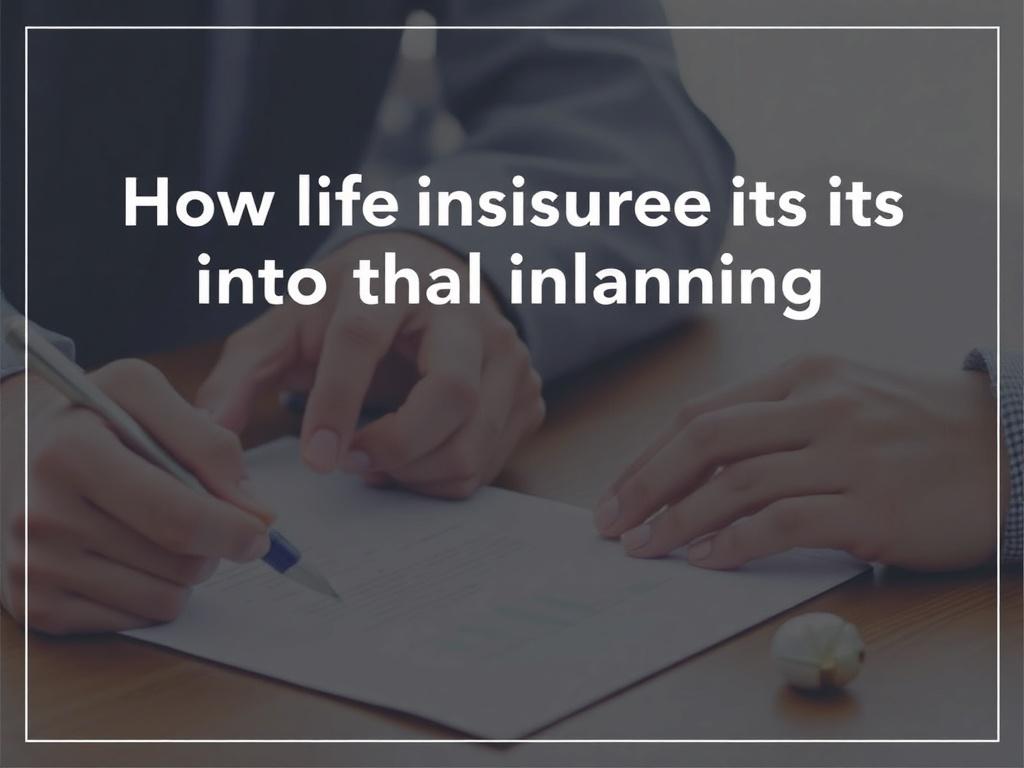SQLITE NOT INSTALLED
Содержание
Understanding the Role of Life Insurance in Financial Planning
Life insurance is often seen merely as a safety net in case the unexpected happens. However, it is much more than just a payout upon death; it is a strategic financial tool that integrates seamlessly into a comprehensive financial plan. For many people, life insurance represents peace of mind, a way to protect loved ones, and a crucial component of long-term wealth management. Before diving into how it fits into financial planning, it’s important to understand the basic types of life insurance and their purposes.
Life insurance policies generally fall into two main categories: term life insurance and permanent life insurance. Term life insurance provides coverage for a specific period, usually 10, 20, or 30 years, and is often chosen to cover temporary needs such as paying off a mortgage or providing income replacement while children are dependent. On the other hand, permanent life insurance, which includes whole life, universal life, and variable life policies, offers lifelong coverage and often builds cash value over time. This cash value can be borrowed against or withdrawn, making permanent life insurance both a protection tool and a financial asset.
The Foundation: Why Life Insurance Is Critical in Financial Planning
Integrating life insurance into your financial planning strategy ensures that your loved ones are financially secure if something happens to you. This financial security can cover expenses like outstanding debts, funeral costs, mortgage payments, and even day-to-day living expenses. Without life insurance, families can face significant financial hardships during an already difficult time.
Something many people overlook is how life insurance can be a part of retirement planning. The cash value component of permanent life insurance can supplement retirement income, providing a tax-advantaged source of funds. Additionally, some life insurance policies come with living benefits, allowing policyholders to access money in the event of a chronic or terminal illness.
Integrating Life Insurance into Your Broader Financial Strategy
Financial planning isn’t just about saving money – it’s about making informed decisions that secure your financial future, and life insurance plays a pivotal role in this. Here’s a breakdown of how life insurance fits into broader financial planning:
- Income Replacement: Life insurance ensures your family has income to maintain their lifestyle after your passing.
- Debt and Expense Coverage: Pays off loans like mortgages, personal loans, and credit card debt.
- Estate Planning: Helps manage estate taxes and ensures smooth wealth transfer.
- Business Protection: Protects business interests in case of the loss of a key person or partner.
- Wealth Building: Permanent life insurance policies offer cash value build-up, acting as an investment component.
By including life insurance in your financial plan, you’re essentially building a multi-layered safety net that not only protects your family but also supports your financial goals.
Life Insurance and Emergency Preparedness
It’s easy to underestimate the importance of financial preparedness for emergencies. Life insurance can play a role here as well, providing liquidity and support when you need it most. The death benefit from a life insurance policy is typically tax-free to beneficiaries, which means it can offer accessible funds without the delay of probate or other financial hurdles.
The Tax Implications: What You Need to Know
Tax considerations make life insurance an even more attractive part of financial planning. The death benefit is generally not subject to federal income tax, providing recipients with hassle-free financial support. Additionally, the cash value growth in a permanent life insurance policy accumulates on a tax-deferred basis, meaning you don’t pay taxes on the growth until you withdraw it. This feature can complement other tax-advantaged retirement accounts, helping diversify your tax exposure.
Determining the Right Amount and Type of Life Insurance

A question many people ask is, “How much life insurance do I really need?” The answer varies based on your circumstances and financial goals. Factors to consider include your current income, debts, future expenses such as college tuition for children, and your spouse’s ability to earn income after your passing.
Here’s a table to help visualize different needs based on life stages:
| Life Stage | Typical Life Insurance Needs | Recommended Type of Policy |
|---|---|---|
| Young Single Adult | Lower, often to cover final expenses | Term Life Insurance |
| New Parents | High, covers income replacement and child care | Term or Permanent Life Insurance |
| Established Family | High, considers mortgage and college costs | Term with a permanent policy for cash value |
| Retirees | Lower, focus on legacy and final expenses | Permanent Life Insurance |
Choosing Between Term and Permanent Life Insurance
While term life insurance is usually more affordable and straightforward, permanent life insurance offers additional benefits that can complement your financial planning strategy. Term policies are generally best if your focus is temporary coverage, such as during years you’re paying off debt or raising children. Permanent policies, meanwhile, provide long-term financial security and the ability to accumulate cash value, which can be used for emergencies, education, or retirement.
How Life Insurance Supports Different Financial Goals
Every financial plan includes specific goals—whether it’s paying off debt, funding education, buying a home, or building wealth. Life insurance supports these goals in unique ways:
- Debt Payoff: Life insurance proceeds can cover outstanding debts, preventing survivors from facing financial burdens.
- Education Funding: Life insurance can guarantee funds for your children’s college education even if you’re not there to provide.
- Wealth Transfer: Permanent life insurance helps ensure that your assets are passed on efficiently, sometimes with additional tax advantages.
- Supplementing Retirement: Some policies allow borrowing against cash value, acting as a supplemental income source in retirement.
- Charitable Giving: Life insurance can be a tool to leave a meaningful legacy through charitable donations.
Life Insurance in Business Planning
If you’re a business owner, life insurance becomes an even more important asset. It can be used to protect your business against financial loss caused by the death of a key employee or partner. Many entrepreneurs purchase buy-sell agreements funded by life insurance to ensure the business can continue operating smoothly when a partner passes away.
Common Misconceptions About Life Insurance in Financial Planning

Despite its importance, life insurance is often misunderstood. Here are some common myths and the reality behind them:
- Myth: “Life insurance is too expensive.”
- Reality: Term life insurance can be very affordable, especially for young, healthy individuals. Permanent insurance has higher premiums but its benefits can justify the cost.
- Myth: “I don’t need life insurance if I’m single.”
- Reality: Even singles can use life insurance for estate planning, covering debts, or providing legacy gifts.
- Myth: “Social Security survivor benefits make life insurance unnecessary.”
- Reality: Survivor benefits are often limited and may not fully replace your income or cover family expenses.
- Myth: “Permanent life insurance is too complicated.”
- Reality: While more complex, permanent life insurance can be tailored to suit a variety of financial goals when understood clearly.
Practical Steps to Incorporate Life Insurance into Your Financial Plan

If you’re ready to integrate life insurance into your overall financial strategy, consider these steps to make the process smooth and effective:
- Assess your financial situation: Analyze your debts, income, family needs, and future financial goals.
- Define your coverage needs: Determine how much insurance you require using online calculators or with the help of a financial advisor.
- Choose the right type: Decide between term, permanent, or a combination based on your priorities and budget.
- Shop and compare: Get quotes from multiple insurance providers to understand rates and policy features.
- Review your policy regularly: Life changes like marriage, new children, or career shifts may require updating your coverage.
Working with a Financial Advisor
A knowledgeable financial advisor can help you understand how life insurance complements other parts of your financial plan. They will look at your unique situation and suggest policies that align with your risk tolerance and goals. Advisors can also help with estate planning, retirement planning, and tax strategies that correspond with your insurance coverage.
The Emotional and Practical Benefits of Life Insurance
Beyond the numbers and financial strategies, life insurance offers emotional comfort. Knowing that your family will be protected financially in difficult times brings reassurance and peace of mind. This peace allows you to focus on living your life fully while safeguarding the future.
Reviewing and Updating Your Life Insurance
Financial planning is an ongoing process, and your life insurance needs will evolve. Major life events—marriage, the birth of a child, divorce, or even retirement—should prompt a review of your policy. Updating your coverage ensures it remains adequate and aligned with your goals.
Summary of Life Insurance Benefits in Financial Planning
| Benefit | Description |
|---|---|
| Financial Security | Protects loved ones from financial hardship. |
| Income Replacement | Ensures ongoing income for dependents. |
| Debt Coverage | Pays off outstanding liabilities to prevent burdening family. |
| Cash Value Accumulation | Offers savings component that can be accessed if needed. |
| Tax Advantages | Death benefits are generally tax-free; cash value grows tax-deferred. |
| Estate and Business Planning | Facilitates easy wealth transfer and protects business interests. |
Conclusion
Life insurance is far more than just a protective measure for after you’re gone; it is a dynamic financial planning tool that can safeguard your family’s future, contribute to wealth accumulation, and provide valuable tax advantages. Whether you choose term life insurance for affordable, focused coverage or permanent life insurance for lifelong protection combined with a cash value component, integrating life insurance into your broader financial plan is essential. Thoughtfully chosen and regularly reviewed, life insurance ensures that your financial goals—be it supporting your family, preparing for retirement, or building wealth—are not left vulnerable. In the end, life insurance provides not only financial security but also peace of mind, allowing you to face the future with confidence.
Опубликовано: 24 July 2025 Кредитрон – блог о кредитах, финансах и прочих реверансах
Кредитрон – блог о кредитах, финансах и прочих реверансах

